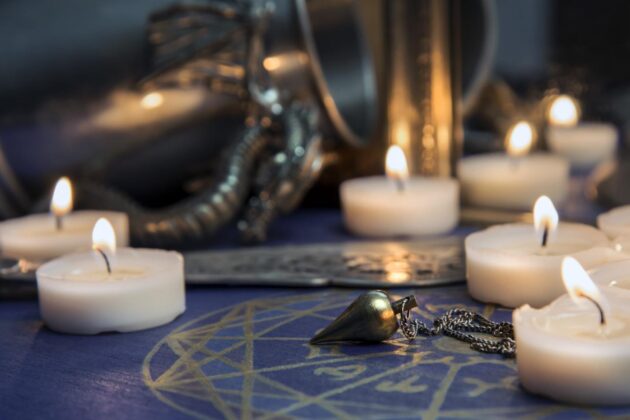As the next generation gets older and more vocal, there is a rising trend in online spaces. Neo-paganism, including Wicca, is rising in popularity. If you’re new to Wicca, you may have a lot of questions and misconceptions about what it really is.
Just as it’s important to understand what Wicca is, it’s important to understand what it is not. Keep reading to learn more.
What is Wicca?
Wicca is an Earth-centered religion that dates back to ancient practices. Wiccans honor the power of Nature to give and sustain life. Many Wiccans commit to living life in balance with the earth and perform ritual worship rites and traditions based on the time of year.
Wicca is dynamic and constantly evolving. No two Wiccans practice the same way, either, so narrowing Wicca down into a few broad topics is difficult to do.
But most Wiccans and other Pagans who do not identify with Wicca can agree with one thing: when they step outside and dip their toes into nature, they experience the presence of the divine.
A Decentralized Religion
Wicca is unique for several reasons. Wicca has no center of worship the way that Christianity or Judaism do. Instead of congregating together into large groups to worship, Wiccans tend to practice alone or in much smaller, less formal groups.
There is no “bible” in Wiccan practices, either. There is also no one universal ideology that all Wiccans are expected to abide by. Many Wiccans hold similar core beliefs, but most change up the way they practice, celebrate, and honor the earth. No one way of practicing Wicca is considered more right than the other.
Some Wiccans view the world through a pantheistic lens, which means that they see the divine source of energy in all living things. Others, however, worship deities from other cultures and some even consider themselves Christian as well.
This fluidity and acceptance are some of the aspects of Paganism that draw people in. Wicca encourages everyone to seek their own path in life and discover their own truths about the world.
What Wicca Is Not
It’s important to remember that Wicca and witchcraft is not a cult. Wiccans do not want or encourage others to follow their lead or claim to be spokespeople for divinity. Wiccans also do not worship Satan or summon demons.
Keep in mind that Satan is a Christian creation. Wicca and Christianity are not intrinsically linked.
Similarly, Wiccans do not sacrifice animals or humans. They don’t steal from or control others with the use of magic or superpowers. The energy they seek comes from their own personal connection with Earth.
Wiccans follow a strict moral code that can be summed up with two simple words: “Harm none.” They believe in the Law of Three which states that whatever they give to the world will come back to them times three, whether it is good or bad.
Wiccan Practices
Wiccans practice with a wide variety of different tools. Some Wiccans have animal guides or totem animals. Totem animals are animals that Wiccans are closely connected with that can serve as guides or inspiration.
Some witches practice candle magic. Candle magic can be used to repel or attract things and it involves cleansing, dressing, and lighting a candle with a specific intention. The specific colors of the candles are important here because each color represents a different intent.
Some Wiccans believe in the East Indian philosophy of Chakras. Chakras are seven major psychic centers of the body that form a link that changes the energy and connects the spiritual, mental, astral, and physical body.
A hugely popular part of Wiccan and other Pagan practices is the incorporation of crystals and gemstones into daily life. For centuries, gemstones and crystals have held mystical appeal. Our ancestors understood the healing properties of gemstones and modern Wiccans are rediscovering and using them in their magical practices and everyday life.
Some Wiccans practice divination, which is when they use an object to answer questions or see events that may be unseeable or unknowable by the average person. They interpret cards, tea leaves, or other divination tools to answer these questions and incorporate them into their magical practice.
Some witches also use various herbs, spices, and essential oils to create protection, fertility, and success spell jars.
Wiccan Holidays
You may be surprised to know that many of the secular holidays we observe in our day-to-day lives are actually borrowed from Pagan and Wiccan practices. Most Wiccan holidays directly correlate with Christian holidays and in many ways the way we observe and celebrate them are similar.
Wiccan holidays are called Sabbats. The sabbats consist of two Solstices, two Equinoxes, and four “earth festivals.” These Sabbats all fall on equidistant places on the wheel of the year.
Samhain
Samhain (pronounced like s-ow-in) falls between October 31 and November 1. The main themes of Samhain are death, rebirth, honoring our ancestors, revelry, and introspection. Samhain is considered the end of the wheel of the year.
This Sabbat marks the end of growing season and the beginning of the harvest. It’s a time to prepare your home, body, and soul for the dark times of winter.
Many of the Halloween traditions that we follow are adapted from Samhain.
Yule
Yule, or the winter solstice, falls between December 20 and December 23. Yule represents rebirth, a new year, new hopes, setting intention, and the celebration of light.
This is the first Sabbat of the new year. Yule is a fire festival and it’s a time to celebrate the lengthening days and the return of the sun. The days will get longer and longer until the summer equinox.
Imbolc
Imbolc takes places between February 1 and February 2. The main themes are pregnancy, renewal, fertility, hearth, home, and light.
This Sabbat celebrates the end of winter and the coming of spring in the Northern Hemisphere. The cold months are drawing to clothes and spring is beginning to make itself known.
Imbolc is a great time to cleanse, dedicate, and purify yourself and your home.
Ostara
Ostara, or the spring equinox, falls between March 19 and March 21. Ostara represents balance, new hopes, new possibilities, renewal, and action.
It marks the mid point between summer and winter, perfectly balancing the two extremes. In the Christian calendar, Ostara most closely represents Easter.
The symbolicism of rabbits and the painting of eggs are both things that stem from Pagan culture.
This holiday is another good time to purify your home and your spirit. Light candles and spend time in the garden. Bake bread with spring-inspired flavors and ready yourself for the sun.
Beltane
Beltane takes place between April 30 and May 1. It’s a time to celebrate passion, sensuality, beauty, romance, sexuality, fertility, and abundance.
Beltane marks the change between spring and summer. It’s time to to bring vitality and new life to the earth. Flowers are blossoming and young animals are beginning to grow into their adult selves.
Love and commitment are two things to focus on during this Sabbat. It is full of sexual and sensual energy.
Litha
Litha, or the summer solstice, falls between June 20 and June 22. Litha is a time to celebrate growth, masculine energy, magic, love, and abundance.
Litha is celebrated on the summer solstice and it is the longest day and shortest night of the year. This means that the sun is at its maximum power, giving way to lots of masculine energy.
The sun will start to set a little earlier every day until Yule. It’s a good time to recognize and thank the sun for all it does.
Lughnasadh
Lughnasadh, also known as Lammas, falls between August 1 and August 2. Lughnasadh represents the first fruits of the harvest, benevolent sacrifice, gratitude, skills, and talents.
This is one of the most important days of the year. It marks the beginning of the harvest season. This is also the hottest part of the summer and it’s the time where autum starts to peek out from the shadows.
Mabon
Mabon, or the autumn equinox, takes place between September 21 and September 24.It’s a time to celebrate the harvest, gratitude, balance, preparation, and welcoming the dark times of the year.
Mabon represents the height of the harvest season and it’s a great time to be thankful for the earth and all she gives us. It’s a time to decorate your altar with acorns, seasonal fruits and nuts, or some of the colored leaves that fall to the ground.
Fall colors like red and orange are great for this celebration as well.
Ready to Learn More?
Wicca is not some hedonistic anti-Christian community full of people who worship the devil and summon demons. It has been largely misrepresented by the Christian church and the media as being something threatening to the way that Christians choose to live their lives. However, nothing could be further from the truth.
Wicca is all about embracing the world and all of its bounty and doing good things so you can get good things back in return.
For more fun facts like these, keep reading!










